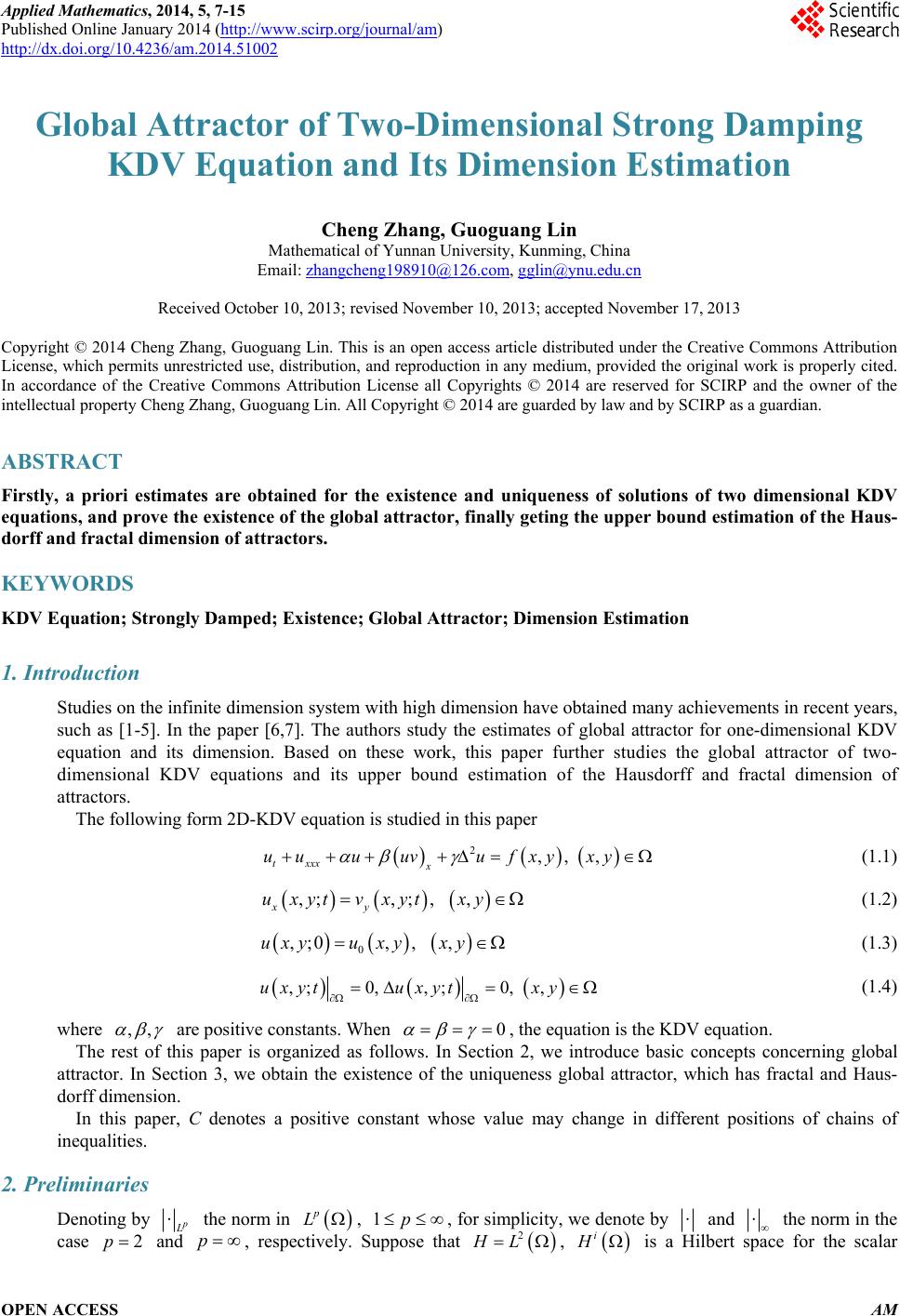 Applied Mathematics, 2014, 5, 7-15 Published Online January 2014 (http://www.scirp.org/journal/am) http://dx.doi.org/10.4236/am.2014.51002 OPEN ACCESS AM Global Attractor of Two-Dimensional Strong Damping KDV Equation and Its Dimension Estimation Cheng Zhang, Guoguang Lin Mathematical of Yunnan University, Kunming, China Email: zhangcheng198910@126.com, gglin@ynu.edu.cn Received October 10, 2013; revised November 10, 2013; accepted November 17, 2013 Copyright © 2014 Cheng Zhang, Guoguang Lin. This is an open access article distributed under the Creative Commons Attribution License, which permits unrestricted use, distribution, and reproduction in any medium, provided the original work is properly cited. In accordance of the Creative Commons Attribution License all Copyrights © 2014 are reserved for SCIRP and the owner of the intellectual property Cheng Zhang, Guoguang Lin. All Copyright © 2014 are guarded by law and by SCIRP as a guardian. ABSTRACT Firstly, a priori estimates are obtained for the existence and uniqueness of solutions of two dimensional KDV equations, and prove the existence of the global attractor, finally geting the upper bound estimation of the Haus- dorff and fractal dimension of attractors. KEYWORDS KDV Equation; Strongly Damped; Existence; Global Attractor; Dimension Estimation 1. Introduction Studies on the infinite dimension system with high dimension have obtained many achievements in recent years, such as [1-5]. In the paper [6,7]. The authors study the estimates of global attractor for one-dimensional KDV equation and its dimension. Based on these work, this paper further studies the global attractor of two- dimensional KDV equations and its upper bound estimation of the Hausdorff and fractal dimension of attractors. The following form 2D-KDV equation is studied in this paper 2,, , t xxxx uuuuvufxy xy (1.1) ,;,; ,, xy uxyt vxytxy (1.2) 0 ,;0, ,,uxyu xyxy (1.3) ,; 0,,; 0,,uxyt uxytxy (1.4) where ,, are positive constants. When 0 , the equation is the KDV equation. The rest of this paper is organized as follows. In Section 2, we introduce basic concepts concerning global attractor. In Section 3, we obtain the existence of the uniqueness global attractor, which has fractal and Haus- dorff dimension. In this paper, C denotes a positive constant whose value may change in different positions of chains of inequalities. 2. Preliminaries Denoting by the norm in p L, 1p , for simplicity, we denote by and the norm in the case 2p and p, respectively. Suppose that 2 HL , i H is a Hilbert space for the scalar 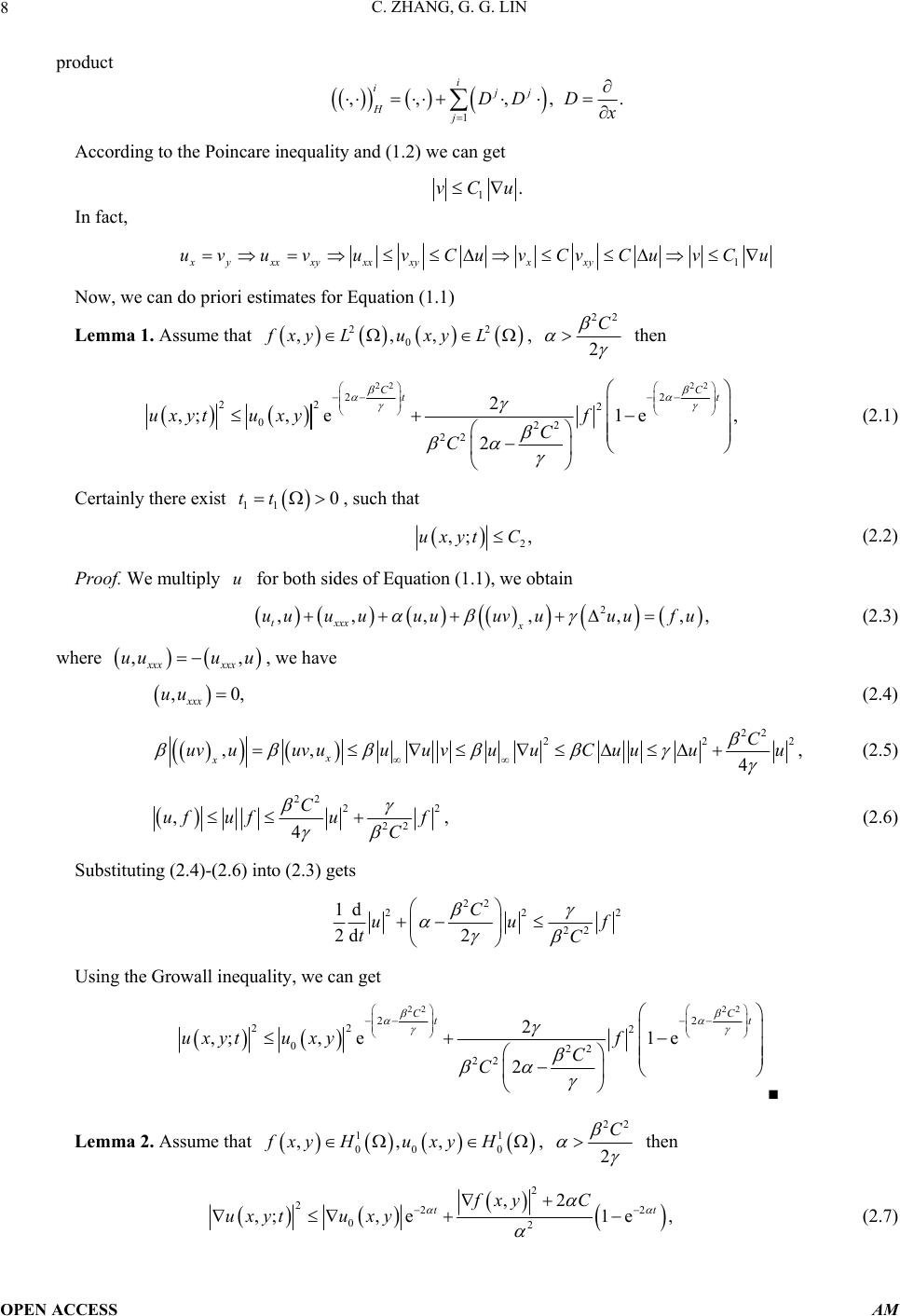 C. ZHANG, G. G. LIN OPEN ACCESS AM 8 product 1 ,,,, . i ijj Hj DD D According to the Poincare inequality and (1.2) we can get 1.vCu In fact, 1xyxx xyxxxyxxy uvuvuvCu vCv Cu vCu Now, we can do priori estimates for Equation (1.1) Lemma 1. Assume that 22 0 ,,,fxyLu xyL , 22 2 C then 22 22 22 22 2 022 22 2 ,;,e1 e, 2 CC tt uxytuxyf C C (2.1) Certainly there exist 11 0tt , such that 2 ,; ,uxyt C (2.2) Proof. We multiply u for both sides of Equation (1.1), we obtain 2 ,,,,,,, txxx x uuuuuuuvuuufu (2.3) where ,, xxx xxx uuu u , we have ,0, xxx uu (2.4) 22 222 ,, , 4 x x C uvuuv uuuvuuCuuuu (2.5) 22 22 22 ,, 4 C uf ufuf C (2.6) Substituting (2.4)-(2.6) into (2.3) gets 22 222 22 1d 2d 2 C uuf tC Using the Growall inequality, we can get 22 22 22 22 2 022 22 2 ,;,e1 e 2 CC tt uxytuxyf C C ■ Lemma 2. Assume that 11 00 0 ,,,fxyH uxyH , 22 2 C then 2 222 02 ,2 ,;,e1 e, tt fxy C uxytu xy (2.7) 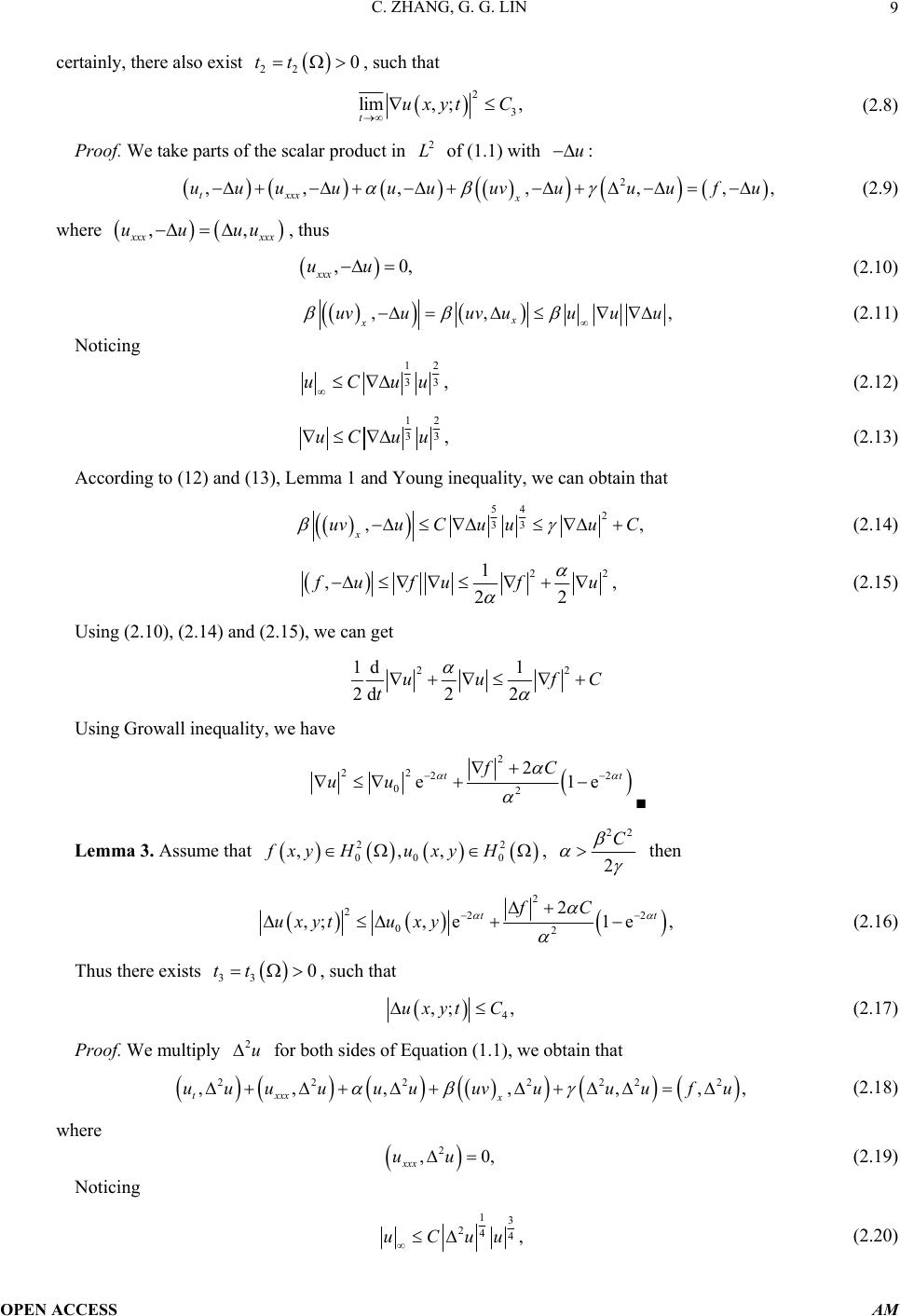 C. ZHANG, G. G. LIN OPEN ACCESS AM 9 certainly, there also exist 22 0tt , such that 2 3 lim, ;, tuxytC (2.8) Proof. We take parts of the scalar product in 2 L of (1.1) with u : 2 ,,,, ,,, txxx x uuu u uuuvuuufu (2.9) where ,, xx xxx uuuu , thus ,0, xxx uu (2.10) ,, , x x uvuuv uuuu (2.11) Noticing 12 33 ,uCuu (2.12) 12 33 ,uC uu (2.13) According to (12) and (13), Lemma 1 and Young inequality, we can obtain that 54 2 33 ,, x uvuCu uuC (2.14) 22 1 ,, 22 ufuf u (2.15) Using (2.10), (2.14) and (2.15), we can get 22 1d 1 2d2 2 uu fC t Using Growall inequality, we have 2 22 22 02 2 e1e tt fC uu ■ Lemma 3. Assume that 22 00 0 ,,,fxyH uxyH , 22 2 C then 2 222 02 2 ,;,e1 e, tt fC uxytuxy (2.16) Thus there exists 33 0tt , such that 4 ,; ,uxyt C (2.17) Proof. We multiply 2u for both sides of Equation (1.1), we obtain that 222 2222 ,,,, ,,, txxx x uuuuuuuvuuufu (2.18) where 2 ,0, xxx uu (2.19) Noticing 13 244,uCuu (2.20) 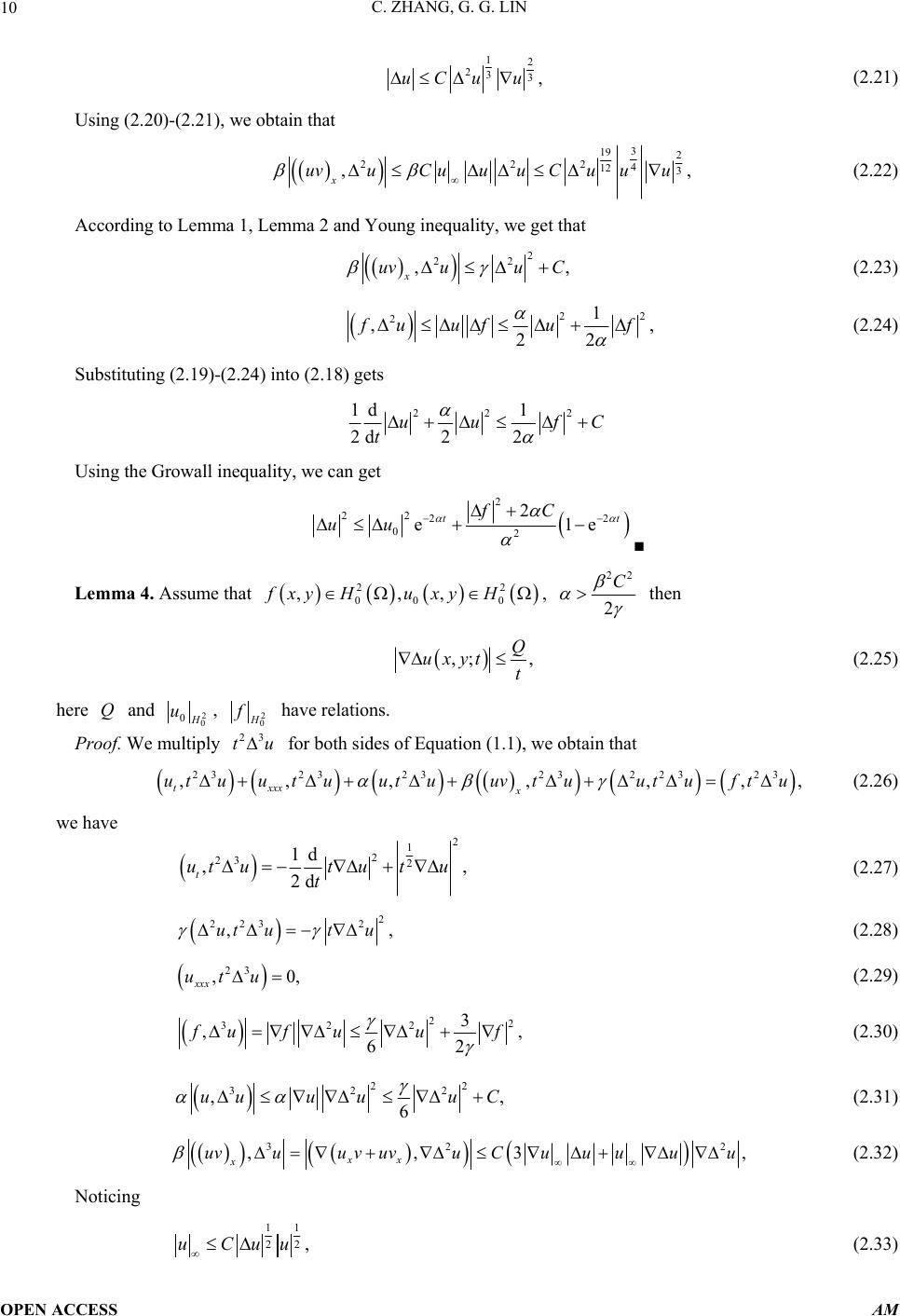 C. ZHANG, G. G. LIN OPEN ACCESS AM 10 12 233,uCu u (2.21) Using (2.20)-(2.21), we obtain that 3 19 2 222 4 12 3 ,, x uvuC uuuCuuu (2.22) According to Lemma 1, Lemma 2 and Young inequality, we get that 2 22 ,, x uvuuC (2.23) 22 21 ,, 22 uuf uf (2.24) Substituting (2.19)-(2.24) into (2.18) gets 22 2 1d 1 2d2 2 uu fC t Using the Growall inequality, we can get 2 22 22 02 2 e1e tt fC uu ■ Lemma 4. Assume that 22 00 0 ,,,fxyH uxyH , 22 2 C then ,; , Q uxyt t (2.25) here Q and 2 0 0 u, 2 0 have relations. Proof. We multiply 23 tu for both sides of Equation (1.1), we obtain that 2323232322323 ,,,, ,,, txxx x utuutuutuuvtuutuftu (2.26) we have 2 1 2 23 2 1d ,, 2d t utut utu t (2.27) 2 2232 ,,ut utu (2.28) 23 ,0, xxx utu (2.29) 22 322 3 ,, 62 ufuu f (2.30) 22 322 ,, 6 uuuuu C (2.31) 32 2 ,,3 , xx x uvuu vuvuCuuuuu (2.32) Noticing 11 22 ,uCuu (2.33)  C. ZHANG, G. G. LIN OPEN ACCESS AM 11 1 324 4,uCu u (2.34) 3 225 5,uCu u (2.35) Taking (2.33)-(2.35) into (2.32) and using Young inequality, we have 2 32 ,, 6 x uvuu C (2.36) namely, 2 23 2 ,, 6 x uv tutuC (2.37) Taking (2.27)-(2.37) into (2.26), we obtain 222 d dtutuCf t So, we get Q ut .■ From [8], we have Theorem 2.1 Let E be a Banach space, St are the semigroup operators. :StEE, StS St , 0SI, here I is unit operator.Set St satisfy the following conditions: 1) St is bounded. namely 0, E RuR, there exist a constant CR, such that Stu 0,CR t . 2) There exist a bounded absorbing set 0 BE, namely BE , there exist a constant 0 t, such that 00 StBB tt . 3) When 0t, St is a completely continuous operator. Then, the semigroup operators St exist a compact global attractor . 3. Global Attractor and Dimension Estimation 3.1. The Existence and Uniqueness of Solution Theorem 3.1 Assume that 2 0 ,fxy H and 2 00 ,uxy H , 22 2 C there exists a unique solution 2 0 ,; 0,;,uxyt LTH (3.1.1) Proof. By the Galerkin method, we can easily obtain the existence of solutions. Next, we prove the uniqueness of solutions. Set 12 uu , where 1, 2 i ui are two solutions of (1.1)-(1.4). then satisfies 2 112 20, t xxxuv uv (3.1.2) d, 1,2, iii ix uvuuy i (3.1.3) ,;00,xy (3.1.4) Take the inner product with , we gets 22 2 112 2 1d ,0, 2d uv uv t (3.1.5) Furthermore  C. ZHANG, G. G. LIN OPEN ACCESS AM 12 222 112 2 22 21 222 21 d2,22 d 2dd,22 22, xx uv uv t uyuy Cuu (3.1.6) Noticing 13 44 ,uCuu (3.1.7) 13 44 ,uCuu (3.1.8) 11 22 ,C (3.1.9) So, we have 13 13 22 22 44 44 22 11 d22 dCuuCu u t From Lemmas 1-3, we have 2211 ,,,uCuCuCuC Using Young inequality, we obtain 22 d dC t Using Gronwall inequality, we have 2 22 0e 0 Ct So, we can get 0. ■ 3.2. Global Attractor Theorem 3.2 Assume that 2 0 ,fxy H and 2 00 ,uxy H , 22 2 C there exists a compact global attractor , such that 1) ,0StA At 2) lim, 0 tdistStBA here, B is a bounded set in 2 0 H. ,inf, sup yY xX distX Yxy St are the semigroup operators. Proof. Let us verify theorem 2.1 conditions (1), (2), (3). In Theorem 3.2 conditions, we know that there exist the solution semigroup St, 2 0 EH , 22 00 :StHH . form Lemmas 1-3, we can get that 2 0 BH is a bounded set and B included in the ball 2 0 H uR, 22 0 22 22 00120 ,;0, . HH StuuxytuCfCtuB This shows that 0St t is uniformly bounded in 2 0 H . Furthermore, when 123 max,,tttt, we have 2 0 22 0234 ,;2 H StuuxytCC C 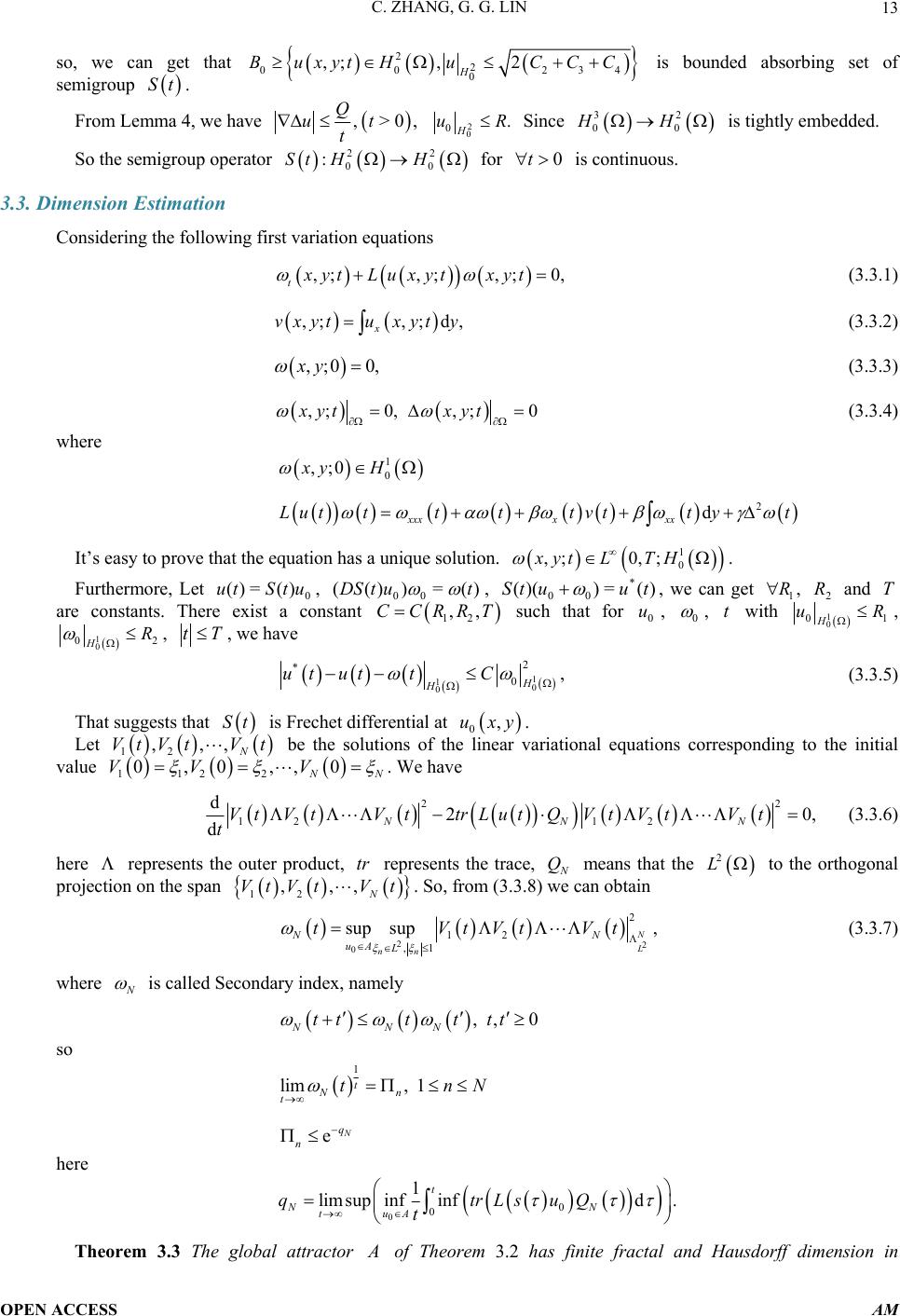 C. ZHANG, G. G. LIN OPEN ACCESS AM 13 so, we can get that 2 2 0 0234 0 ,;, 2 H BuxytH uCCC is bounded absorbing set of semigroup St. From Lemma 4, we have ,>0, Q ut t 2 0 0. H uR Since 32 00 HH is tightly embedded. So the semigroup operator 22 00 :StHH for 0t is continuous. 3.3. Dimension Estimation Considering the following first variation equations ,;,;,; 0, txyt Luxytxyt (3.3.1) ,;,;d, x vxytu xyty (3.3.2) ,;00,xy (3.3.3) ,; 0, ,; 0xyt xyt (3.3.4) where 1 0 ,;0xy H 2 d xxxx xx Lutttt tvttyt It’s easy to prove that the equation has a unique solution. 1 0 ,; 0,;xyt LTH . Furthermore, Let 0 )(=)( utStu , )(=))((00 tutDS , )(=))((* 00 tuutS , we can get 1 R, 2 R and T are constants. There exist a constant 12 ,,CCRRT such that for 0 u, 0 , t with 1 0 01 H uR , 1 0 02 HR , tT, we have 1 10 0 2 * 0, H H ut uttC (3.3.5) That suggests that St is Frechet differential at 0,uxy . Let 12 ,,, N VtVtVt be the solutions of the linear variational equations corresponding to the initial value 112 2 0,0,,0 NN VV V . We have 22 12 12 d20, dNNN VtVtV ttrLutQVtVtV t t (3.3.6) here represents the outer product, tr represents the trace, Q means that the 2 L to the orthogonal projection on the span 12 ,,, N VtVtV t. So, from (3.3.8) we can obtain 22 0 2 12 ,1 , sup supN L nn NN uA L tVtVtVt (3.3.7) where is called Secondary index, namely ,,0 NNN tttttt so 1 lim, 1 t Nn ttnN eN q n here 0 0 0 1 limsup infinfd. t NN tuA qtrLsuQ t Theorem 3.3 The global attractor of Theorem 3.2 has finite fractal and Hausdorff dimension in 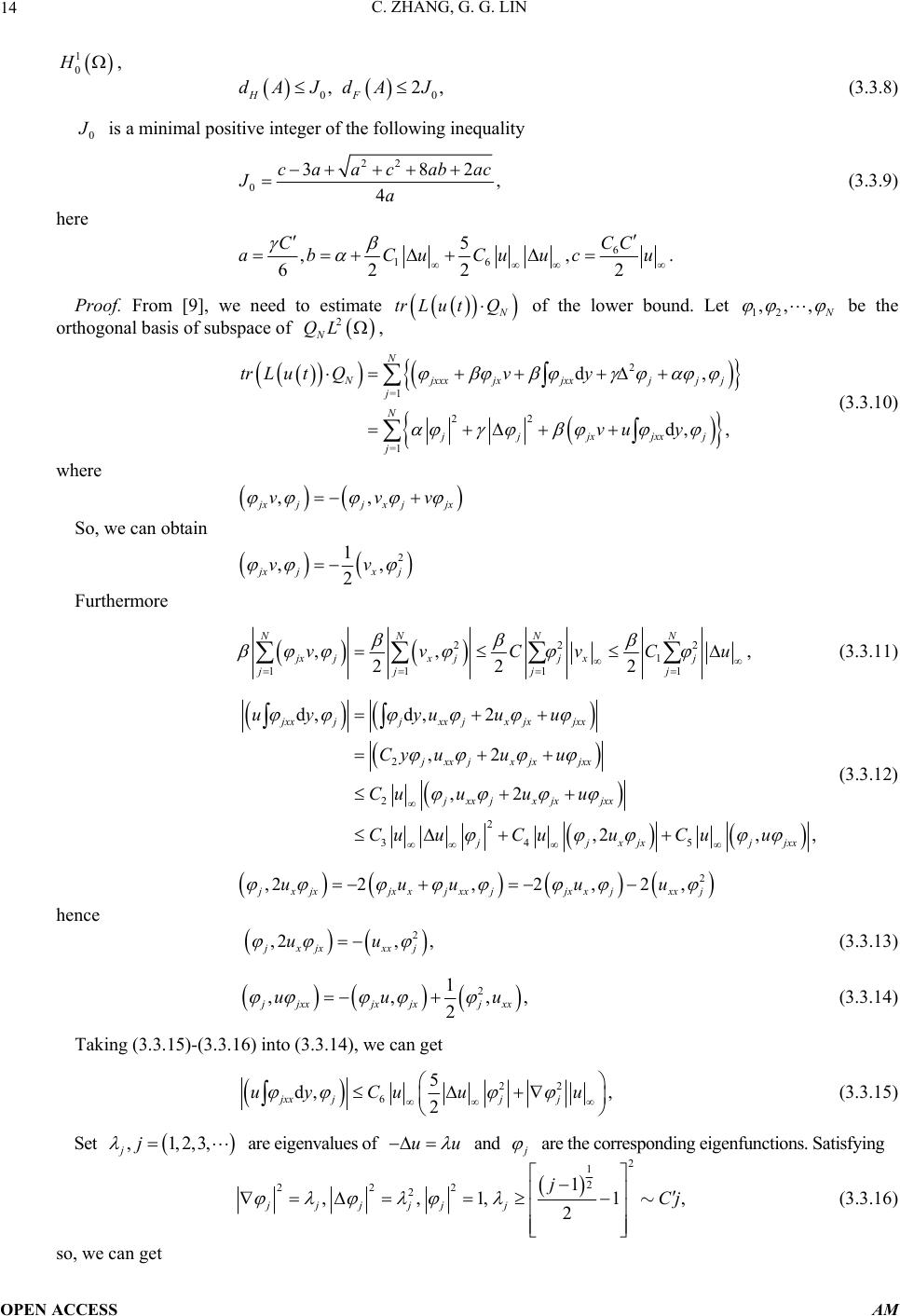 C. ZHANG, G. G. LIN OPEN ACCESS AM 14 1 0 H, 00 ,2, HF dAJdA J (3.3.8) 0 is a minimal positive integer of the following inequality 22 0 382 , 4 c aacabac Ja (3.3.9) here 6 16 5 ,,. 62 22 CC C abCuCuuc u Proof. From [9], we need to estimate N trLu tQ of the lower bound. Let 12 ,,, be the orthogonal basis of subspace of 2 N QL , 2 =1 22 =1 d, d, , N Njxxxjxjxxjj j j N jjjxjxx j j trL u tQvy vu y (3.3.10) where ,, jxjjx jjx vvv So, we can obtain 2 1 ,, 2 xj xj vv Furthermore 22 2 1 11 11 ,, , 22 2 NNNN jxjx jjxj jj jj vvCvCu (3.3.11) 2 2 2 34 5 d,d, 2 ,2 ,2 ,2, , jxxjj xxjxjxjxx j xxjxjxjxx j xxjxjxjxx jjxjxjjxx uyyu uu Cy uuu Cuuu u Cu uCuuCuu (3.3.12) 2 ,22,2,2, jxjxjx xj xxjjx xjxxj uuu uu hence 2 ,2, , jxjxxxj uu (3.3.13) 2 1 ,,,, 2 jjxxjxjx jxx uu u (3.3.14) Taking (3.3.15)-(3.3.16) into (3.3.14), we can get 22 6 5 d, , 2 jxx jjj uy Cuuu (3.3.15) Set ,1,2,3, jj are eigenvalues of uu and are the corresponding eigenfunctions. Satisfying 2 1 2 222 21 ,,1, 1, 2 jjjjj j jCj (3.3.16) so, we can get 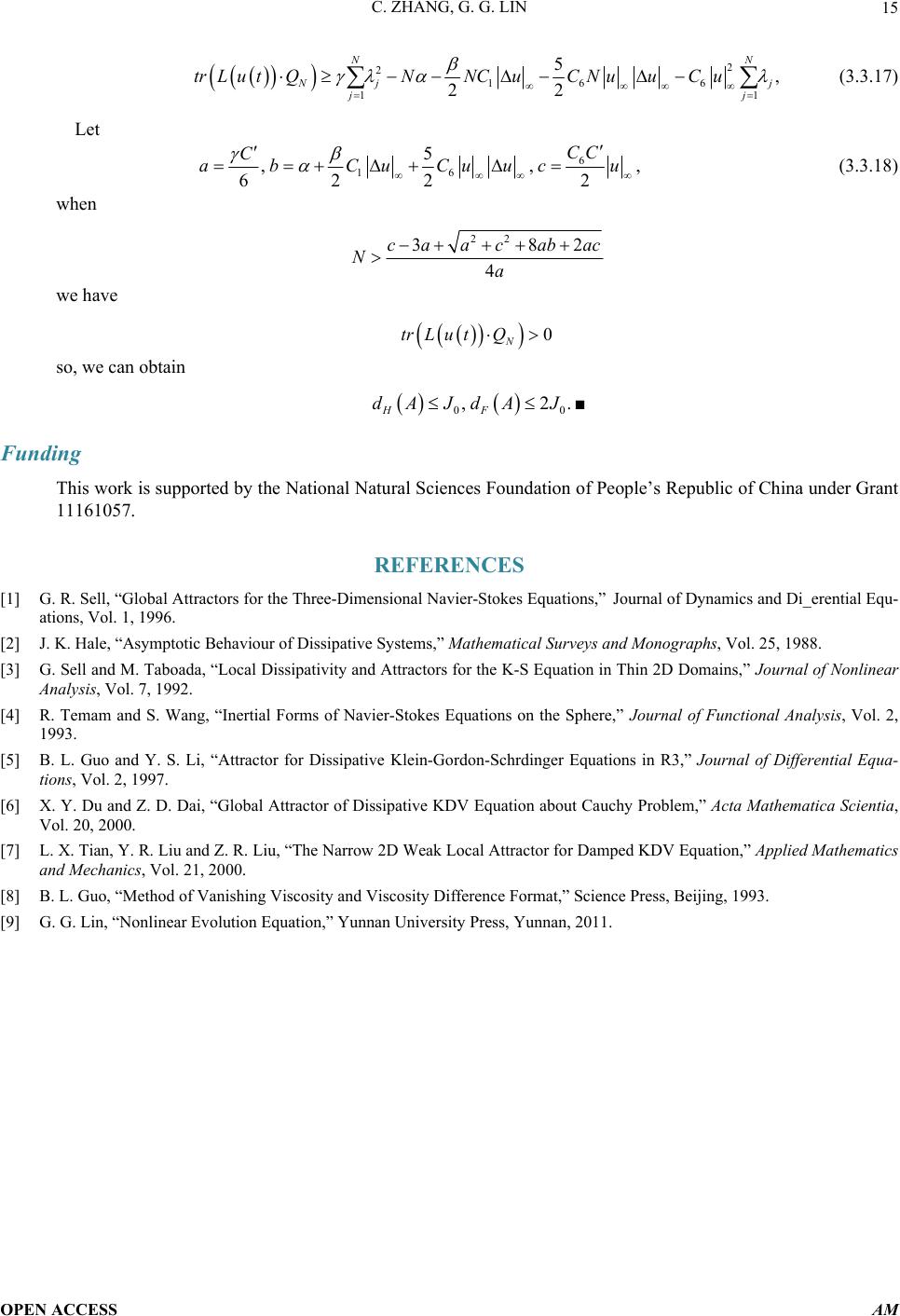 C. ZHANG, G. G. LIN OPEN ACCESS AM 15 2 2 16 6 1 1 5, 22 N N j j j j trLutQNNCuC N uuCu (3.3.17) Let 6 16 5 ,,, 622 2 CC C abCuCuuc u (3.3.18) when 22 382 4 ca acabac Na we have 0 N trLu tQ so, we can obtain 00 ,2. HF dAJdA J ■ Funding This work is supported by the National Natural Sciences Foundation of People’s Republic of China under Grant 11161057. REFERENCES [1] G. R. Sell, “Global Attractors for the Three-Dimensional Navier-Stokes Equations,” Journal of Dynamics and Di_erential Equ- ations, Vol. 1, 1996. [2] J. K. Hale, “Asymptotic Behaviour of Dissipative Systems,” Mathematical Surveys and Monographs, Vol. 25, 1988. [3] G. Sell and M. Taboada, “Local Dissipativity and Attractors for the K-S Equation in Thin 2D Domains,” Journal of Nonlinear Analysis, Vol. 7, 1992. [4] R. Temam and S. Wang, “Inertial Forms of Navier-Stokes Equations on the Sphere,” Journal of Functional Analysis, Vol. 2, 1993. [5] B. L. Guo and Y. S. Li, “Attractor for Dissipative Klein-Gordon-Schrdinger Equations in R3,” Journal of Differential Equa- tions, Vol. 2, 1997. [6] X. Y. Du and Z. D. Dai, “Global Attractor of Dissipative KDV Equation about Cauchy Problem,” Acta Mathematica Scientia, Vol. 20, 2000. [7] L. X. Tian, Y. R. Liu and Z. R. Liu, “The Narrow 2D Weak Local Attractor for Damped KDV Equation,” Applied Mathematics and Mechanics, Vol. 21, 2000. [8] B. L. Guo, “Method of Vanishing Viscosity and Viscosity Difference Format,” Science Press, Beijing, 1993. [9] G. G. Lin, “Nonlinear Evolution Equation,” Yunnan University Press, Yunnan, 2011.
|